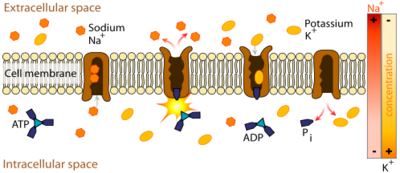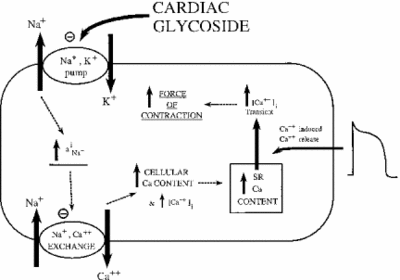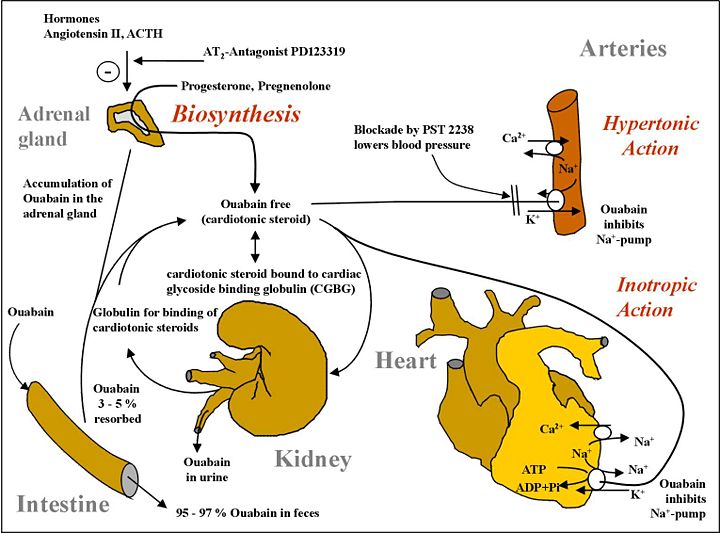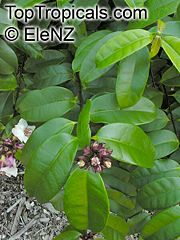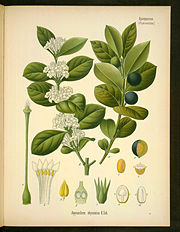Ouabain
From Proteopedia
| Line 13: | Line 13: | ||
==Cardiac Muscle and Ion Pump Inhibition== | ==Cardiac Muscle and Ion Pump Inhibition== | ||
The inhibition of Na+/K+ ATPase has indirect effects on the contractile strength, or inotrophy, of cardiac muscle cells. Through the increase in cytoplasmic sodium concentration, a sodium-''calcium'' exchanger is activated, thereby increasing the cellular concentration of calcium. Calcium is a second messenger in many signaling/regulatory pathways. Its release into the cytoplasm of muscle cells signals contraction, explaining the positive effect of low doses of ouabain on cardiac introphy. The image below depicts this effect of all cardiac glycosides on myocardial tissue. As is shown, the inhibition of the sodium-potassium pump causes elevated cytoplasmic sodium, which activates the sodium-calcium pump causing in increase in cytoplasmic calcium. This increases the force with which the cell contracts. | The inhibition of Na+/K+ ATPase has indirect effects on the contractile strength, or inotrophy, of cardiac muscle cells. Through the increase in cytoplasmic sodium concentration, a sodium-''calcium'' exchanger is activated, thereby increasing the cellular concentration of calcium. Calcium is a second messenger in many signaling/regulatory pathways. Its release into the cytoplasm of muscle cells signals contraction, explaining the positive effect of low doses of ouabain on cardiac introphy. The image below depicts this effect of all cardiac glycosides on myocardial tissue. As is shown, the inhibition of the sodium-potassium pump causes elevated cytoplasmic sodium, which activates the sodium-calcium pump causing in increase in cytoplasmic calcium. This increases the force with which the cell contracts. | ||
| - | [[Image:Cs0950003f03.gif]] | + | [[Image:Cs0950003f03.gif|center|400px]] |
If dosed correctly, ouabain proves to be effective in treating heart failure and arrhythmias. However, ouabain activity can indirectly contribute to the overloading of myocardial cells with sodium. Passive Na+ channels are usually inactivated when membrane potential is at its highest. When they re-open or fail to close, too much sodium can leak into the cell, causing the wasteful expenditure of ATP and/or uncoordinated muscle contraction. This is called late I-Na. With the rise of sodium and calcium, a Ca2+-calmodulin-dependent kinase is activated, in turn phosphorylating and activating passive Na+ channels. When the effects of ouabain are amplified in this way, the drug can cause more harm than good. Research has shown that an effective way to combat late I-Na is by the inhibition of the Ca2+-calmodulin-dependent kinase ([http://jpet.aspetjournals.org/content/early/2011/02/16/jpet.110.176776.full.pdf Hoyer et al. 2011]). | If dosed correctly, ouabain proves to be effective in treating heart failure and arrhythmias. However, ouabain activity can indirectly contribute to the overloading of myocardial cells with sodium. Passive Na+ channels are usually inactivated when membrane potential is at its highest. When they re-open or fail to close, too much sodium can leak into the cell, causing the wasteful expenditure of ATP and/or uncoordinated muscle contraction. This is called late I-Na. With the rise of sodium and calcium, a Ca2+-calmodulin-dependent kinase is activated, in turn phosphorylating and activating passive Na+ channels. When the effects of ouabain are amplified in this way, the drug can cause more harm than good. Research has shown that an effective way to combat late I-Na is by the inhibition of the Ca2+-calmodulin-dependent kinase ([http://jpet.aspetjournals.org/content/early/2011/02/16/jpet.110.176776.full.pdf Hoyer et al. 2011]). | ||
Revision as of 20:54, 15 August 2011
| |||||||||||
Sources
It was recently discovered that ouabain, long thought to be exclusively a plant product, is actually synthesized by animals, and secreted from the adrenal cortex to regulate body osmosis and cellular concentrations of sodium. The image below represents its biosynthesis and metabolism in humans.
Though there are currently synthetic schemes for the production of Ouabain, the compound is usually extracted from the plant sources Strophanthus gratus (left) and Acokanthera schimperi. Somalia is both the native habitat of these plants and the etymological origin of the name ouabain. Somalian tribes have historically used ouabain poisoned arrows for hunting. These arrows are capable of killing a hippopotamus, likely due to cardiac arrest.
